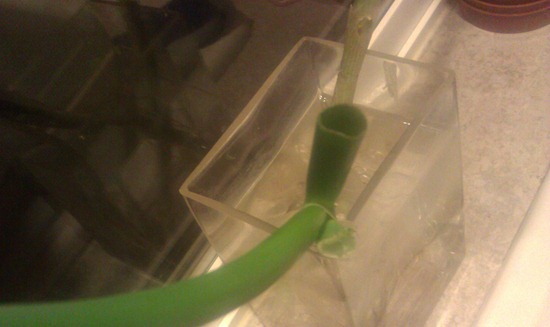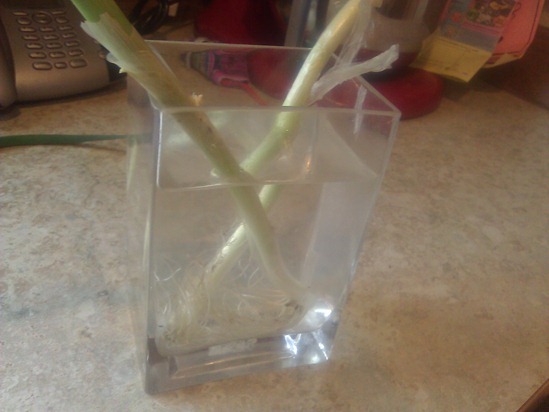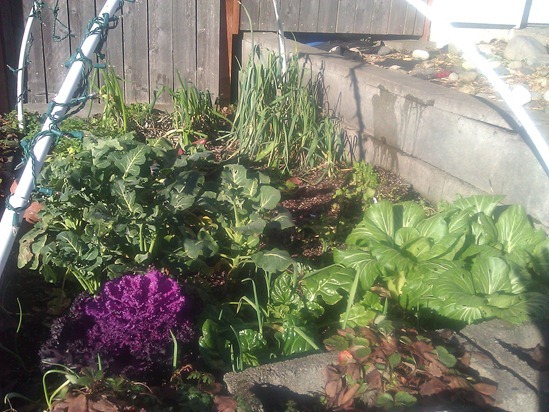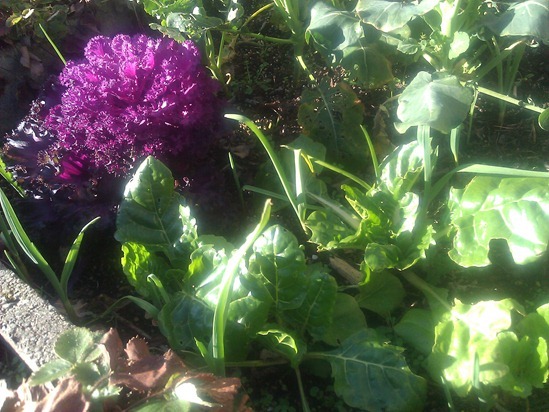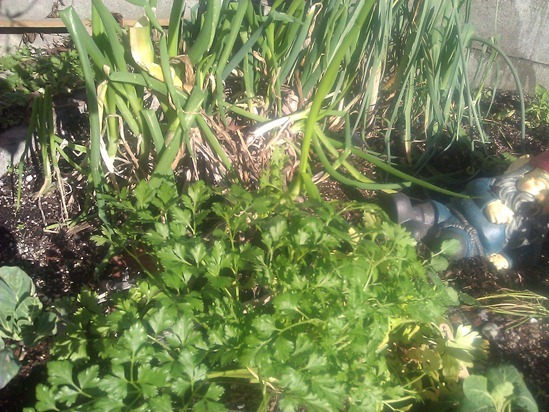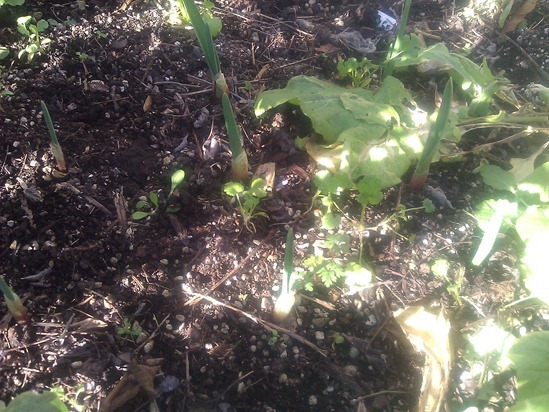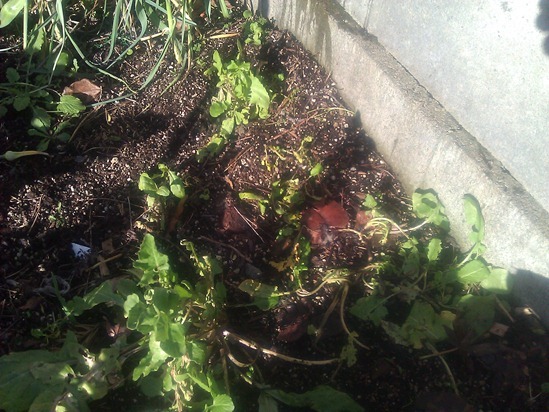Plan your garden with Sprout Robot
12.2 years ago gardening software, indoor seed starting, robot, seeds, sprouting
I came across Sprout Robot in the past week, you simply create an account and provide your zip code and it will give you a complete calendar of planting dates as well as follow ups when to expect sprouts to form, when to bring out, harvest etc.
When a new event is coming up you will get an email similar to the one below letting you know what is new to plant that week.
When you connect to the site you then can “Check-In” and check off the tasks you have completed which get updated with next event for that plant.
They also have an option where they will even send out organic seeds just in time for planting in your area starting at $19.99 a year, though personally I have plenty of seeds saved for at a couple of years in my refrigerator.
Never ending green onions growing in your kitchen
12.2 years ago green onions, onions
I like to add some green onions to my omelets in the morning, though it is not too convenient to pick them out in the winter garden when it is raining or snowing on these cold mornings. I decided to pick a couple plants the day before and placed them in water to last a little longer.
To my surprise not only did the onions last longer they actually kept growing. So I just cut off what I need and more is waiting for me after a few days. All I do is changes the water every few days and enjoy my seemingly endless supply of green onions (ok…will keep growing until the bulb runs out of energy…)
Making the Most Out of a Small Space
12.2 years ago cucumbers, peas, trellis
There is a common misconception that you need to have a huge sprawling garden to be able to grow vegetables, but that is simply not true. Even the smallest of gardens can grow sumptuous vegetables. By utilizing the space you have available you can grow a wide variety of climbing vegetables. Whether you have a gazebo, a trellis or just an outside wall you can plant some truly succulent vegetables, which will produce not only food, but also some amazing flowers too.
Runner beans are a great plant to start with; all they need is sunshine and fertile soil. They also produce flowers, which are certainly a welcome addition to any garden. For runner beans you need to either make a wigwam, lashed together with string at the top, or create a parallel row of canes, which are firmly secured to a horizontal cane running along the top. The best time to plant Runner Beans is a week before the last frost; these plants are originally from South America so die out every year after the frost. Runner beans need to be watered particularly heavily, but twice a week in dry weather.
Japanese cucumbers, which will reach several feet, are a more demanding vegetable, and require different types of fertilizer at different times of the development, although all the hard work is certainly worth it, especially when you get to taste your produce. Although not widely known, several of the smaller pumpkin species, including trailing pumpkins, can be grown vertically. These are easy to grow and even easier to cook and enjoy! Marrows will also clamber over fences, or up trellises. All you need to do is prepare the soil well, with lots of fertilizer.
There are hundreds of things that you can grow up a trellis over a wall and even up a gazebo, so this spring make the most out of the space you have!
Using GrowVeg to discover new vegetables to grow
12.2 years ago gardening software, growveg, indoor seed starting
It seems like every year there is something I decide I want to grow in my garden only to discover I am a couple months late to get started. In the past season this was brussel sprouts, I had grand visions of growing them this winter only to discover I should have started the seeds back in March…
I got a great idea when I was planning this years garden in GrowVeg where I simply created a plot and just dropped in each vegetable that I typically eat and enjoy regardless is I have grown them in the past or plan to in the future.
This way when the time comes when I should be planting these I will see this on the chart I printed out and get a reminder email in my mailbox from GrowVeg I can make this impulse decision to get seeds and start these plants at a time where I can still be successful.
Just by doing this exercise I have decided to consider fennel, Jerusalem artichoke, parsnips, and sweet potatoes. Sure many of these may result in utter failures in my cold damp area but at least I can make sure I can start at the right time to give them a fighting chance.
the best fertilizers for carrots
12.2 years ago carrot, fertilizer, guest post
Most of the gardeners love to grow carrots because of the low-maintenance efforts. However, you need to pay some attention one week after sowing the seeds. Carrots need some specific soil conditions in order to be healthy and tasteful. Therefore, before sowing the seeds and also after the seed germination, you need to check the soil to see if it is proper for the healthy growth of the plant. A light sandy soil with lots of potassium and some amount of nitrogen, phosphorus and other micronutrients works best of carrots. So, a soil test is necessary before you plant your carrots, so that you can add the nutrients that are deficient in the soil. Some of the fertilizers that are most suitable for carrots are:
Potash
Potash is a fertilizer that provides potassium. Carrots need a lot of potassium for their growth. If your soil is deficient in potassium, you need to add potash in it. Potassium helps carrot plants in their photosynthesis, water as well as nutrient transport and also plant cooling. Deficiency of potassium can make the leaves to curl and their margins will have a burnt look. Stems also become abnormally short and stunted. Alkaline soil, however, does not require a lot of potassium, but if you have an acidic soil, add potash to make it alkaline before you sow the carrot seeds.
Kelp
Kelp enriches the soil with micronutrients such as calcium, magnesium and boron. These are required by the plant for chlorophyll production. If your soil has a micronutrient deficiency, you need to add kelp. Calcium deficiency can cause stems to collapse and leaves to wither off. Less magnesium can lead to yellowing of the leaves. Carrots with boron deficiency have leaves that have a rosette pattern and they usually turn orange when they grow old. So, to help your carrot plants to grow better, nourish the soil with kelp. Avoid overuse of this fertilizer, as it causes the carrots to become fibrous.
NPK fertilizers
Nitrogen, phosphorus and potassium are the three main macronutrients that are required by the carrot plants. Before sowing your seeds, make sure that your soil has a proper percentage of these macronutrients. These nutrients help in photosynthesis, proper root and leaf formation and the overall development of the plant. Their deficiency can lead to pale leaves and stunted plants that can die soon. NPK fertilizers release all the three nutrients and make it suitable for the growth of carrots. This fertilizer can be added to the soil 30 days after the germination of the seeds. For carrot plants, the amount of nitrogen in the fertilizer should be less than potassium and phosphorus. NPK fertilizer with 1-2-2 label can be perfect. Carrot is a root plant and too much of nitrogen can enhance the growth of leaves and make the carrots hairy and cracked. However, take care not to even overuse phosphorus, as it leads to water pollution.
Therefore, before planting carrots, ensure that your soil has all the nutrients required for the proper growth of the plant. If there is a deficiency, add fertilizers. With little care, you can enjoy tasty, healthy and nutritious homegrown carrots, which are far better than the carrots you find in the market. Always avoid over-fertilization, as this might ruin the flavor of the carrots. Remember to water your plants properly after you add fertilizers.
About The Author: Alia is a blogger by profession. She loves writing on luxury and Designer Rugs. Beside this she is very particular about her fitness and exercise daily to stay in shape. She frequently writes articles related to plastic pollution for her blog Ecofriend.
Winter garden survivors
12.2 years ago bok choy, garlic bulbs, kale, winter garden
Saturday we had a rare occurrence here in the Pacific Northwest, this large ball of warm gas, which in some areas they refer to as the sun made an appearance. It raised the temperature so much I had to take the cover off my winter garden so I decided to do a little weeding and take some pictures.
The Chinese cabbage (bok choy) is looking great and I need to remember to cook with it shortly.
The kale and Swiss chard is also growing strong…think I might have some cooked greens in my future.
The parsley and onions needed a little cleaning up but still nice and green.
The garlic bulbs planted last fall are now starting to emerge with some stray cilantro in gabs between them.
The arugula is still alive but a little mangled from some of the snow that the hoop cover did not keep entirely off. For the beginning of February the garden looks the most alive it has ever been this time of year.


